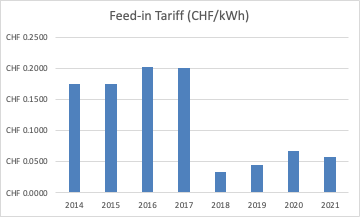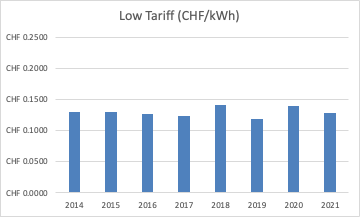Empowering Solar Independence: An Economic Perspective
Written on
As previously discussed, achieving self-sufficiency in energy for a contemporary single-family residence is attainable, even when factoring in electric vehicles, particularly in temperate regions like Switzerland.

As a business owner, I am keenly interested in both technological innovations and their economic viability. This article will delve into the financial aspects of my solar energy setup, building upon the technological insights shared in my prior writing.
The Setup Recap
We constructed our home in 2012, prioritizing energy efficiency from the outset. Equipped with a Drexel+Weiss Aerosmart X2 heating and ventilation system alongside a ground heat pump, our energy consumption for heating has remained minimal—approximately 1.2 kW on the coldest winter days.
After several years of residence and monitoring our energy usage, we incrementally added the following components:
- 8 kWp east-west solar panels on the carport
- 14 kWp east-west solar panels on the house
- 12 kWh Fronius Solar Battery
- Two Tesla Model 3 vehicles, each with a 75 kWh battery
A Loxone building management system oversees our major energy consumers (electric vehicles, washing machine, heating system), optimizing energy usage based on solar availability, battery levels, and seasonal changes.
Investments
Our financial commitment towards solar energy infrastructure includes:
- 2014: Carport solar panels, inclusive of inverter: 20k CHF
- 2016: House solar panels, inclusive of inverter and battery: 60k CHF
- 2017: Intelligent building control system: 2.5k CHF
- 2017: First smart EV charging station: 1.5k CHF
- 2019: Second smart EV charging station: 1.5k CHF
In total, we have invested roughly 85k CHF in solar energy infrastructure over the years, and remarkably, no components—such as inverters or panels—have failed. The entire setup remains maintenance-free, incurring no significant operational costs post-installation.
Earnings and Savings
Our solar infrastructure has resulted in various income and savings streams:
- Government subsidies supporting solar initiatives
- Feed-in tariffs from the local utility for excess energy fed into the grid
- Compensation for self-generated energy consumption
- Savings on fuel for our vehicles
Let’s explore each stream in greater detail.
Subsidies
Initially, we received substantial subsidies from local authorities, which have gradually decreased. In my view, technology subsidies should be time-limited, aimed at aiding early adopters when the costs of new technologies remain high. These incentives are vital for fostering greater adoption and driving down costs.
We secured 20k CHF in subsidies from 2015 to 2018, although I have not tracked their evolution since completing our installation. While some debate the value of subsidies, I align with Christoph Brand, CEO of Axpo, in recognizing that fossil fuels receive global subsidies without accounting for their environmental impact.
Feed-in Remuneration
In Switzerland, owners of solar energy systems can sell excess energy back to the grid, receiving remuneration from local utilities. Rates differ by community but are generally under pressure nationwide.
From 2014 to 2021, we contributed 73 MWh back to the grid, earning approximately 7.5k CHF. However, as more solar energy systems are implemented, feed-in tariffs are expected to decline, as illustrated in the accompanying chart.

As solar capacity grows, I predict further reductions in feed-in rates, while energy costs may rise, particularly during non-sunny hours.
Self-Consumption Compensation
Our building management system optimizes self-consumption of solar energy, integrating the solar battery and electric vehicle charging schedules. Between 2014 and 2021, we self-consumed 37 MWh, translating to about 5k CHF in equivalent savings. A significant portion of this self-consumption was used to charge our vehicles, with our solar battery enabling complete self-sufficiency from March to October.
To maintain conservative estimates, I based my calculations on lower tariff prices.

Electricity prices have remained relatively stable from 2014 to 2021, yet future fluctuations are anticipated due to geopolitical tensions affecting energy supplies. Christoph Brand has suggested four necessary measures for addressing power shortages in Switzerland, including increased photovoltaic area and stable hydropower production.
However, with the current geopolitical climate, the feasibility of importing electricity or building gas power plants is uncertain, particularly as countries prioritize their own needs during crises, as experienced during the COVID-19 pandemic.
Thus, maximizing self-consumption remains a prudent strategy for optimizing the returns on our solar investment.
Fuel Savings from Electric Vehicles
Before transitioning to electric vehicles, we drove a Volvo V50, which averaged 5 liters of diesel per 100 km. From 2017 to 2021, we covered 77,000 km in our electric cars, resulting in savings of approximately 7k CHF by avoiding diesel purchases.
Charging at home remains the most economical refueling option; on-the-go charging is considerably more expensive due to the infrastructure costs associated with fast-charging stations.
Bottom Line
Overall, our investment of around 85k CHF has yielded approximately 40k CHF in compensations and savings from 2014 to 2021. Whether this constitutes a sound investment remains to be seen, as I consider myself a pioneer in this field.
Given my conservative estimates for savings and actual values for investments, I anticipate the business case is likely on the cautious side. It will be fascinating to monitor the trajectory of electric mobility and its implications for grid infrastructure and electricity pricing.
Having experienced eight years of maintenance-free operation, a 30% efficiency improvement from the Model S/X to the Model 3, and observing geopolitical shifts, I am optimistic about breaking even within another eight years.
I plan to further invest in my energy infrastructure, with vertical panels on the façade to enhance winter energy production as my next project.
The Price of Resilience
In conclusion, recent months have highlighted that energy access transcends environmental issues—it is also a matter of geopolitical significance. We currently observe energy being leveraged as a geopolitical tool, with leaders like Mr. Putin holding sway over our energy future.
Current energy assumptions are fundamentally flawed: the belief that electricity is always available and that power generation must be profitable.
The COVID-19 pandemic taught us that economic optimization in healthcare cannot prepare us for unexpected surges in demand. If Russian gas ceases to flow into Europe next winter, would you prefer to face total power loss or just a financial shortfall on your 85k CHF investment?
Growing a company in challenging times is indeed a marathon.
As a tech entrepreneur, reserve officer, and father of three, I offer practical advice on entrepreneurship and resilience across all life aspects. I strive to be direct and meaningful, recognizing the busy nature of entrepreneurs.
When not engaged in work, I find rest and inspiration in the stunning mountains surrounding Zermatt.
Join over 100 subscribers for my weekly newsletter tailored for resilient entrepreneurs every Friday afternoon!
Download my eBook to ensure you’re never left in the dark as a homeowner!